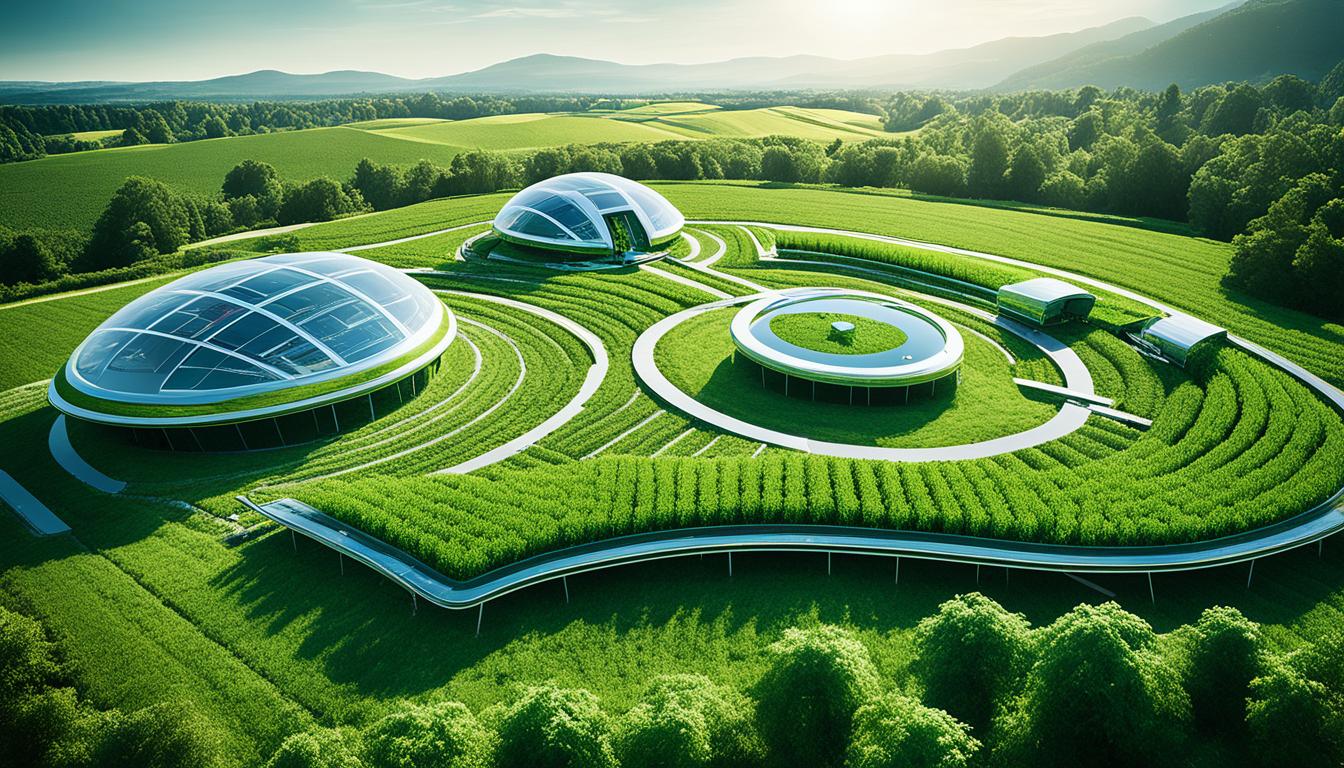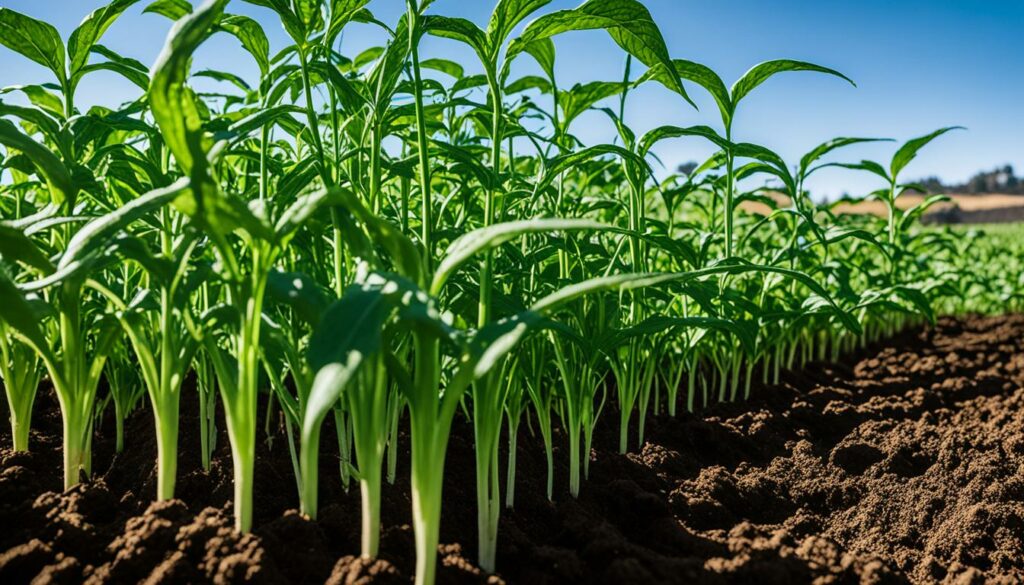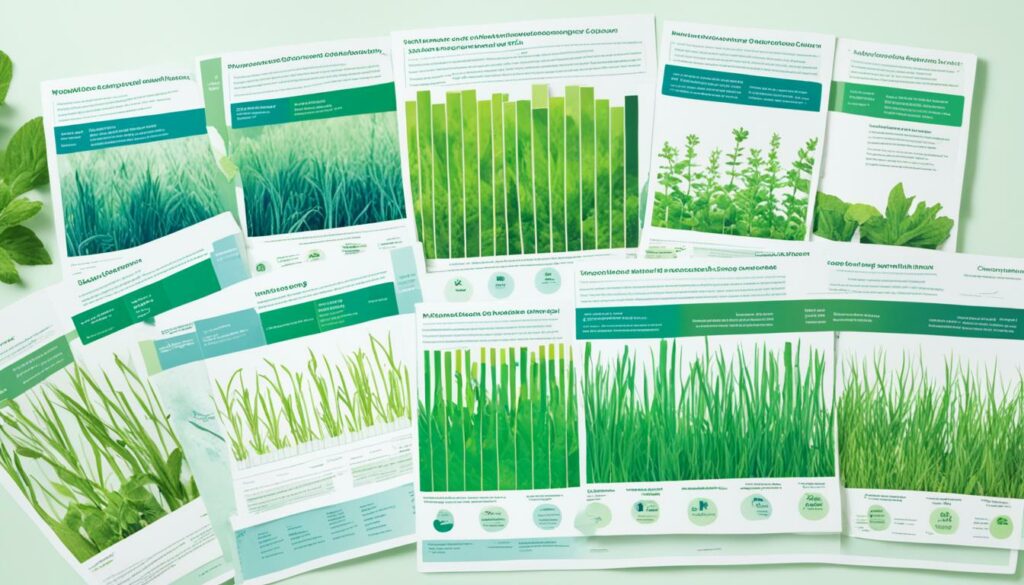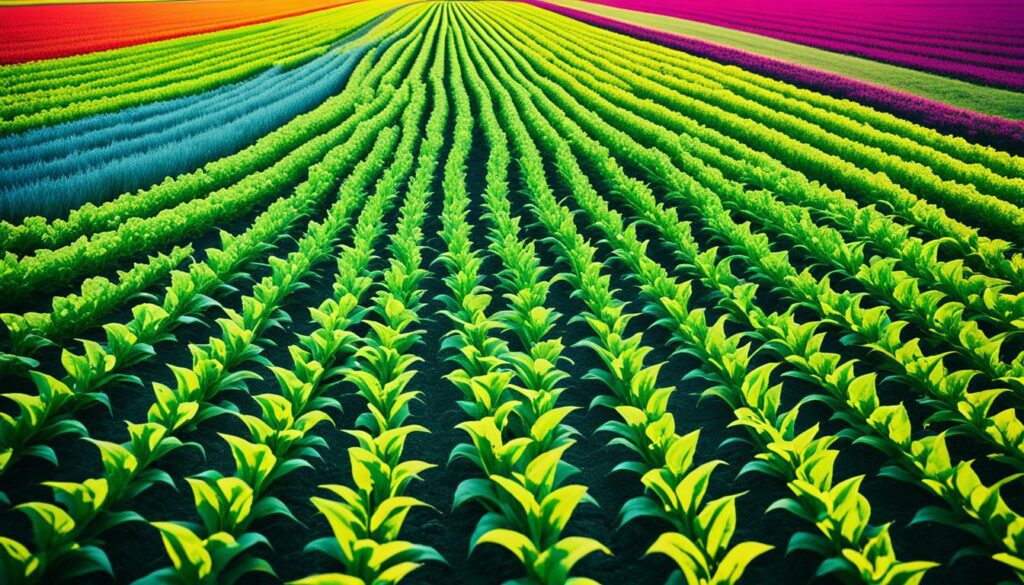Menu

In 2012, 94 percent of cotton, 88 percent of corn, and 93 percent of soybeans in the U.S. came from biotech plantings. This shows how much biotechnology has changed farming. It’s clear that tech innovations are truly changing how we farm around the world.
Biotech uses tools like genetic engineering to make crops and animals better. This technology has created plants that can tolerate herbicides and resist pests. Because of this, farmers use fewer chemicals, saving money and the environment.
Biotech farming is showing great results. Farmers see better crops and animals, need less fertiliser, and can grow things faster and healthier. This not only makes farming more money-smart but also secures our food and helps the planet.
I can’t wait to dive into these biotech farming stories with you. We’ll see how smart farming and tech research are changing our world for the greener.
Biotechnology has changed farming and food in big ways. It uses both old and new methods to make crops and animals better. This mix helps our farms be more eco-friendly and productive.
Agricultural biotechnology is about using science to make plants, animals, and tiny life forms better for farming. This includes mixing them together traditionally and using recent genetic techniques. These methods do a lot, like making crops bigger or healthier, or even helping in making things we use every day.
For instance, some crops can handle weed killers better. This makes farming safer for the environment. There are also plants that help clean soil in polluted places.
People have always tried to make plants and animals better through traditional methods. But now, with genetic engineering, we can do so much more. In the US, almost all of the corn, cotton, and soybeans are grown from biotech crops. This shows how fast this new tech has become a key part of farming.
This new technology has not only made crops stronger and bigger. It has also cut down on the need for harmful chemicals. This protects the earth’s water from getting too polluted.
“Biotech crops have played a significant role in reducing the use of synthetic pesticides, such as insect-resistant cotton leading to decreased pesticide contamination of groundwater.”
These new ways in farming have made a big impact. They have helped crops fight off diseases and made our food healthier. The future looks bright for what else we can achieve through these new technologies.
Genetic engineering has changed how we view crop science. It involves changing crop DNA to add good qualities. These can be resistance to bugs, diseases, or the ability to handle weed killers.

In 1983, the first genetically modified plant was crafted. Since that time, we have made big steps in agricultural biotechnology. Techniques like CRISPR/Cas9 edit plant genes very precisely. This makes crops better at fighting bugs, diseases, and tough weather.
In the US, many farmers use genetically modified crops. A lot of corn, soybeans, and cotton are engineered, showing farmers trust them. These crops can resist bugs and weed killers. They also live longer after being harvested. This means less pesticide and better money for farmers.
| Crop | Adoption Rate | Key Traits |
|---|---|---|
| Corn | 88% | Herbicide Tolerance, Pest Resistance |
| Soybeans | 93% | Herbicide Tolerance, Disease Resistance |
| Cotton | 94% | Herbicide Tolerance, Pest Resistance |
Studies on these engineered crops show big pay offs. They help control weeds and are good for the environment too. It shows using these new plant science ideas helps make farming last longer.
Biotechnological innovations have improved how crops resist pests and diseases. This makes our food supplies safer and more stable. Agribusiness case studies show that crops like cotton and papaya have changed farming across the world.
GM cotton is a great example. It has a gene from the Bacillus thuringiensis (Bt) that fights bollworms. This means less need for chemical pesticides. It helps make farming better for our planet. About 80% of processed foods have something from biotechnology. So, these changes are very important for farming today.
Another big win is ringspot virus-resistant papaya. Researchers saved Hawaii’s papaya industry with this tech. It’s a top biotech win, making the fruit safer from disease. Also, researchers found a gene, GRP8, that helps plants in tough times. This discovery makes farming better and more sustainable.
Biotechnology is vital for sustainable farming. It reduces pesticide use and saves natural resources. Genetically modified crops help keep the environment healthy. They lower synthetic pesticide use, which helps our ecosystem stay balanced.

Crops that resist pests need less pesticide. Bt cotton and Bt maize, for example, have cut down on pesticide use. This is good for our environment and the farmers. Genetically modified crops also yield more food. This helps meet the growing global food demand.
Biotechnology helps save natural resources. It makes crops that need less water and fertiliser. This is key in places with little water. Using less of these resources keeps our soil and ecosystems healthier. It also makes farming more productive.
For example, using Trichoderma spp. in pineapple farms increases yields by 10 to 12 percent. This shows how biotech can help with food security. BioTech is a big player. They are working on ways to cut down fertiliser use by 50%. This is good for the economy and the planet.
The future of farming depends a lot on biotechnology. As the world’s population grows, we need more food. We also need to fight climate change. So, using genetically modified crops smartly is very important.
Agricultural biotechnology has pushed biofuels into the spotlight as a smart and green energy source. It’s all about using crops that work hard and don’t harm the planet. These crops help in making biofuels a great alternative to fossil fuels.
Crops like corn stover, sugarcane bagasse, and switchgrass are key in making biofuels. They’re really good at turning plants into fuel. This technology has shown that specially bred plants can do a lot more, growing better and stronger. They’re perfect for making biofuels.
| Biofuel Crop | Region | Productivity Benefits |
|---|---|---|
| Corn Stover | U.S. and EU | Enhanced yields through genetic engineering |
| Sugarcane Bagasse | Brazil | High biomass production with minimal inputs |
| Switchgrass | North America | Adaptability to diverse soil conditions |
Biofuels are a win for the environment. They help cut down on the gases causing climate change. This lowers the pollution from farming. Also, these fuels don’t need to use up current farmlands. So, they help save forests and keep land from getting worn out. This shows how farming can lead the way to a greener future.
Biotechnology has improved plant growth and seed quality, vital for food security. Scientists have used genetic engineering to make crops survive tough conditions. This has led to stronger plants.

Using CRISPR/Cas9, scientists can edit plant genes precisely. This has helped crops like maize, rice, and muskmelon to become more resistant to heat, herbicides, and diseases. Editing genes like OsProDH in rice has increased its ability to tackle stress.
Biotechnologies have also enhanced seed quality and nutritional value. Crops like oilseed rape and soybean have seen better seeds because of these efforts. Now, seeds can grow well in tough environments and help feed the world.
| Crop | Genetic Modification | Outcome | t
|---|---|---|
| Rice | Manipulation of OsProDH | Enhanced thermotolerance | t
| Maize | CRISPR/Cas9 Editing | Improved plant height and flowering time | t
| Soybean | Gene Knockout for Disease Resistance | Increased disease resistance | t
| Oilseed Rape | Herbicide Resistance | Effective weed control | t
The progress in biotechnology plays a key role in meeting global food needs and tackling environmental issues. These advances highlight the significance of biotechnological innovations for a sustainable agricultural future.
Phytoremediation is a useful way to tackle pollution using plants. It uses special plants to clean contaminated land naturally.
One method, called chelate-assisted phytoextraction, is great at removing heavy metals. Brassica juncea can take out lead, especially the M-30 line, which does it really well. This process also works for cleaning up uranium.
There are plants altered to handle more cadmium, a harmful metal. Plants like Thlaspi goesingense can collect nickel and zinc in large amounts. They are much better at this than regular plants.
Phytoremediation works well in many polluted places. A specific plant, the hybrid 60/31, is great at removing lead, nickel, and zinc from the soil. It’s strong and can take in a lot of metals.
For places with trichloroethylene (TCE), special poplar trees show promise. They turn TCE into less harmful things just by growing there. This method not only helps clean the air but also supports eco-friendly farming and pollution cleanup.
| Biotech Farming Case Studies | Findings |
|---|---|
| Lead Phytoextraction by Brassica juncea | Mutant line M-30 phytoextracted 104% more lead |
| Cadmium Tolerance in Transgenic Plants | Enhanced cadmium tolerance with metallothionein-II gene |
| Nickel and Zinc Accumulation in Thlaspi species | Accumulates 1-5% of dry biomass |
| Hybrid 60/31 in Metal-Contaminated Soil | Increased resistance and biomass for effective phytoextraction |
| TCE Degradation in Hybrid Poplars | Converted TCE to CO2 and chlorine ions |
In farming, gene editing is a big step forward. It helps make crops more nutritious. Technologies like CRISPR can change a plant’s genes without adding new DNA. This makes for crops with better qualities and fewer surprises.

Gene editing boosts the good stuff in crops. Golden Rice is a great example. It has more beta-carotene to fight Vitamin A lack globally. This kind of work helps tackle big health issues and supports making crops good for you and the planet.
Now, food can be safer for those with allergies thanks to gene editing. Methods like CRISPR can turn off genes that make food items like peanuts and wheat risky for some. It cuts the chance of bad reactions in people who are sensitive. This makes food safer and opens up more options for those with allergies.
These new farming techniques make food healthier. They help fight nutrient problems and make food safer for everyone.
Biotechnology has hugely changed the way we farm animals and care for them. It boosts animal health and makes farms more productive. These changes come from new technologies that help protect and improve the animals we raise.
Biotechnology has given us new and better vaccines for animals. These vaccines fight off diseases like foot and mouth and rabies. Not only do they make animals healthier, but they also help farms work better. This is a great example of deep agricultural technology research.
Biotechnology has changed the way we breed animals for the better. Now, we use advanced methods like picking the best genes, artificial insemination, and DNA tests. This makes animals healthier, grow faster, and give better products. Goats are a good example because they produce a lot of milk quickly. This shows how much better farming can be with biotechnology.
| Species | Applications | Benefits |
|---|---|---|
| Goats | Transgenic production of biologically active proteins | High milk yield, short gestation period |
| Sheep | Biopharm development | Increased protein yield per animal |
| Cows | Therapeutic protein production | Cost-competitive large-scale production |
| Rabbits | Genetically engineered for research | Efficient protein production |
Biotech farming led to big changes worldwide, helping farmers and saving the environment. This is shown in many real examples, proving the importance of biotechnology in farming today. 
In the United States, biotech crops have made a big difference. By 2012, most of the corn, cotton, and soybeans grown were from biotech seeds. These reduce the need for harmful pesticides, making farming safer and more eco-friendly.
Herbicide-tolerant crops have enabled farmers to use reduced-risk herbicides that are safe for both wildlife and humans. For example, insect-resistant cotton lowers pesticide need, protecting water sources. Also, disease-resistant papayas keep the U.S. industry safe.
Studies prove biotechnology helps farmers a lot by making work easier and boosting earnings. For instance, growing GM corn in the Philippines increased farm earnings by USD 105 per hectare. This led to less need for workers, but they earn more elsewhere, too.
Biotech also benefits the environment. In the Philippines, where water erosion is a big issue, biotechnology can help a lot. It reduces the chance of landslides, showing a clear benefit for nature.
| Biotech Crop | Adoption Rate (2012) | Key Benefits |
|---|---|---|
| Corn | 88% | Reduced pesticide use, increased income |
| Cotton | 94% | Less synthetic pesticides, protects groundwater |
| Soybeans | 93% | Use non-toxic herbicides, better crops |
| Papaya | Not specified | Resists diseases, secures industry future |
Many farm success stories show how important biotechnology is for the future of farming. It boosts profit and saves the environment. This data proves biotech is key for making farming better, for everyone and the earth.
Global warming is a big challenge. Yet, biotechnology gives us hope for the future. It helps make farming strong and lasting against the earth’s changing climate. By creating tough plants, this science fights climate change directly.
Drought-resistant crops are a huge step forward. In dry parts of the US, special corn varieties are doing well. Thanks to genetic tweaking, they survive and even thrive in tough spots. The same goes for wheat in Argentina and Brazil. These plants keep growing, even when rain is scarce. It proves how biotechnology supports farming that lasts.
Salinity-tolerant crops are another big win. Many areas suffer from salty soil, making farming hard. But, with biotech’s help, plants can now handle the salt. This means more land can be used for farming. It’s a key step to keeping harvests up while dealing with salty soil.
Even animals are getting heat-proof thanks to biotech. Cattle that can handle warm temps better are being bred. These steps help make farming smarter against the changing climate. Thus, both crop and animal farming are growing ready for whatever the climate throws at them.
The future is coming fast, with nine billion people by 2030. Ramping up biotech is crucial for our food and the earth. The US says farming and forestry made 10.5% of its green gas in 2018. This shows how much we need these new farming ways.
We need to keep pushing for new farming methods. America is leading this charge. It’s finding ways to farm better without harming the planet. Big crops like maize, rice, wheat, and soybean must grow quicker to feed everyone. Biotechnology is a big part of making that happen.
By using these new tools, we make farming that can face the future. The ways these tools help us farm sustainably matter a lot. They are our key to feeding the world and saving the planet for the next generations.
The world of regulating biotech crops involves many parts of the government. In the United States, three key federal agencies are in charge. These are the Food and Drug Administration (FDA), the Department of Agriculture (USDA), and the Environmental Protection Agency (EPA).
Each of these agencies has a job to check if genetically modified crops are safe and work well. They do this by looking at lots of data.
The FDA checks that food and animal feed from biotech crops are safe. They have groups like the Center for Food Safety and Applied Nutrition. The Center for Veterinary Medicine is also involved.
The USDA uses laws to make sure these crops don’t have harmful pests or diseases. They watch over biotech crops to protect plants and people. The EPA checks the safety of pesticides used with biotech crops. They work to keep us and the environment safe.

Looking around the world, different countries have their own rules for biotech crops. For instance, Canada has given the green light to 123 kinds of crops in the last 25 years. Almost all the canola grown in Canada can resist herbicides.
Canada started researching biotech crops back in 1986. They’ve been at the forefront of this technology. Now, rules about changing plant genes with new tools are also getting updated.
These new tools are changing how we think about safety rules. The goal is to focus more on the product being safe. This could make sure new agri-tech reaches the market more quickly. It’s all about keeping people and nature safe.
To sum up, regulating biotech crops is complex but very important. It needs careful checking to make sure everything is safe and good for the environment. This shows how serious we take making progress in farming while keeping an eye on safety.
The field of biotechnology is always changing, aiming for better and greener farming. In my research, I see how mixing genetic science and crop studies will change farming. It’s clear this mix will transform the industry.
Right now, enhancing soybean protein is a key research focus. By getting rid of things that reduce nutrition and cause allergies, soybeans are becoming more nutritious. Also, scientists are finding ways to add missing essential amino acids to soy proteins. This makes soy even healthier and supports wider aims for innovation in agriculture.
There are many exciting opportunities ahead. For instance, there are efforts to make soybeans rich in methionine, an essential amino acid. There have also been steps to get rid of big allergens through gene silencing. Even though these are possible, making them available to everyone is not easy. But, working on crops that are super nutritious is crucial. This is because more than two billion people lack important vitamins and minerals. Improving the iron in crops can greatly help, particularly to fight anemia in women.
| Research Area | Focus | Impact |
|---|---|---|
| Transgenic Soybeans | Enhance protein quality, eliminate allergens | Improved nutritional profile |
| Genetic Engineering | Address amino acid deficiencies | Higher nutrient density |
| Methionine-rich Proteins | Feasibility demonstrated, not commercialised | Potential for widespread health benefits |
| Gene Silencing | Eliminate allergens | Reduced dietary risks |
Looking ahead, biotechnology is full of promise. These changes are not just about farming. They’re about making the world resilient and well-fed, showing the power of crop science developments.
Exploring biotech farming cases clearly shows how this technology changes our food world. In places where we grow transgenic crops, there’s no proof they cause big health or environmental issues. This shows we can use biotech crops safely. It also shows that bugs like monarch butterflies and crop pests survive well.
Farmers get big wins from this too. They use less pesticide and move from toxic to safer chemicals. This is good for everyone’s health and helps the environment. They also see more good bugs and birds returning because of these changes.
New technology is making these crops even safer. We’re now able to make them without using some risky components. This makes sure the crops are safe for people and won’t harm the environment. Biotech crops are also designed to avoid pests becoming resistant.
Efforts are made to avoid the spread of genes to other plants. This work tries to keep biotech crops separated from non-biotech ones. Big groups like the Nuffield Council and FAO check bio-engineered products really carefully to keep us all safe.
West Africa is trying hard to use biotech farming for better food but it has funding issues. The goal is to help its own food supply, not the EU’s. They want to keep growing in this field by learning more about safety and building skills in biology.
Finally, these stories show how biotechnology is changing farming for the better. It helps us tackle problems now and in the future. More innovations and strict rules are key to make sure biotechnology keeps doing good for us and the planet.
Advances in biotech farming improve crop quality and yield. They reduce the need for fertilisers through better nutrient use. Besides, this farming method creates crops and animals with faster growth, better nutrients, and the power to fight off diseases.
Biotechnology in agriculture uses genetic engineering to make better plants, animals, and microorganisms. Its scope is wide, including traditional and new breeding techniques. These methods boost crop yields and quality. They also create new products for industries and medicines.
In the past, people mainly used traditional breeding to improve plants and animals. But, genetic engineering has opened new doors in recent years. It has brought about a big change in how we do farming, leading to major innovations.
Genetic engineering changes crop genes to add good traits, like pest resistance. This leads to crops that are easier to grow and manage.
In the US, lots of farmers use GM crops like corn, soybeans, and cotton. About 88%, 93%, and 94% of these crops are GM, respectively. GM crops have cut down on pesticide use and helped control weeds better. This is great for the environment and farmers’ wallets.
Biotech has made crops better at fighting off pests. This means less need for pest-killing chemicals. It’s good for the earth and makes farming more sustainable.
One great example is GM papaya in Hawaii. It is resistant to a virus and saved the papaya industry. So, there’s less need for harmful chemicals now.
By making crops that pests don’t like, we use fewer harmful pesticides. This is a big win for the planet and food quality.
Biotechnology helps by making crops that need less water and fertilisers to grow. This cuts down on resources used in farming.
Biofuels come from plants like corn stover and sugarcane bagasse. They are better for the environment than petrol products.
The process of making biofuels is good for the planet. It lessens our carbon footprint and uses lands in new, helpful ways.
By using genetic engineering, plants can grow faster. They are also better at surviving tough conditions like drought or salt. This helps farming be more productive and sustainable.
Biotech has made seeds that grow better and offer more nutrition. This boosts crop yield and quality.
Phytoremediation uses special plants to clean polluted soils naturally. It makes the soil healthier and the environment cleaner.
Some plants are so good at cleaning soils that they’ve made industrial areas safer. These include areas with heavy metals and chemicals.
Gene editing can make crops more nutritious by changing their genes. For example, rice can be made to have more beta-carotene to fight malnutrition.
Biotech helps to make foods that cause fewer allergies. It’s done by changing the proteins in foods that some people react to.
Biotech has made animal care better. It has improved vaccines and breeding. This leads to animals that are healthier and produce better products.
Global success stories show how biotech farming can have big positive effects. Farmers grow more, their crops fight diseases better, and they make more money. This proves that biotech is important in farming with real-world success.
Biotech helps by making crops that deal with climate challenges like drought and salt. This makes farming more sustainable, fighting climate change.
In the USA, agencies like the USDA, FDA, and EPA make sure GM crops are safe. They check them well before they can be used by the public.
The rules on GM crops vary around the world. They depend on different countries’ views on science and laws. Still, they all focus on making sure biotech crops are safe.
New trends in biotech research focus on gene editing and making plants with stronger abilities against environmental stresses. These trends show promises for future farming.
In the future, we might see created organisms that can recycle plastics. There’s also hope for even stronger and more productive crops and animals. This shows the future potential of biotech in agriculture.